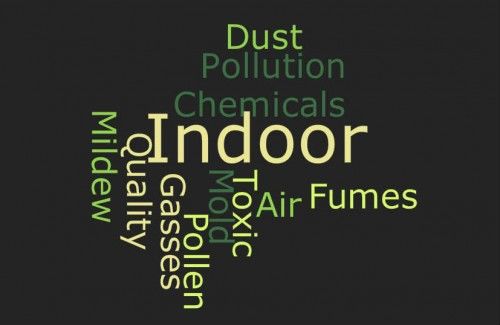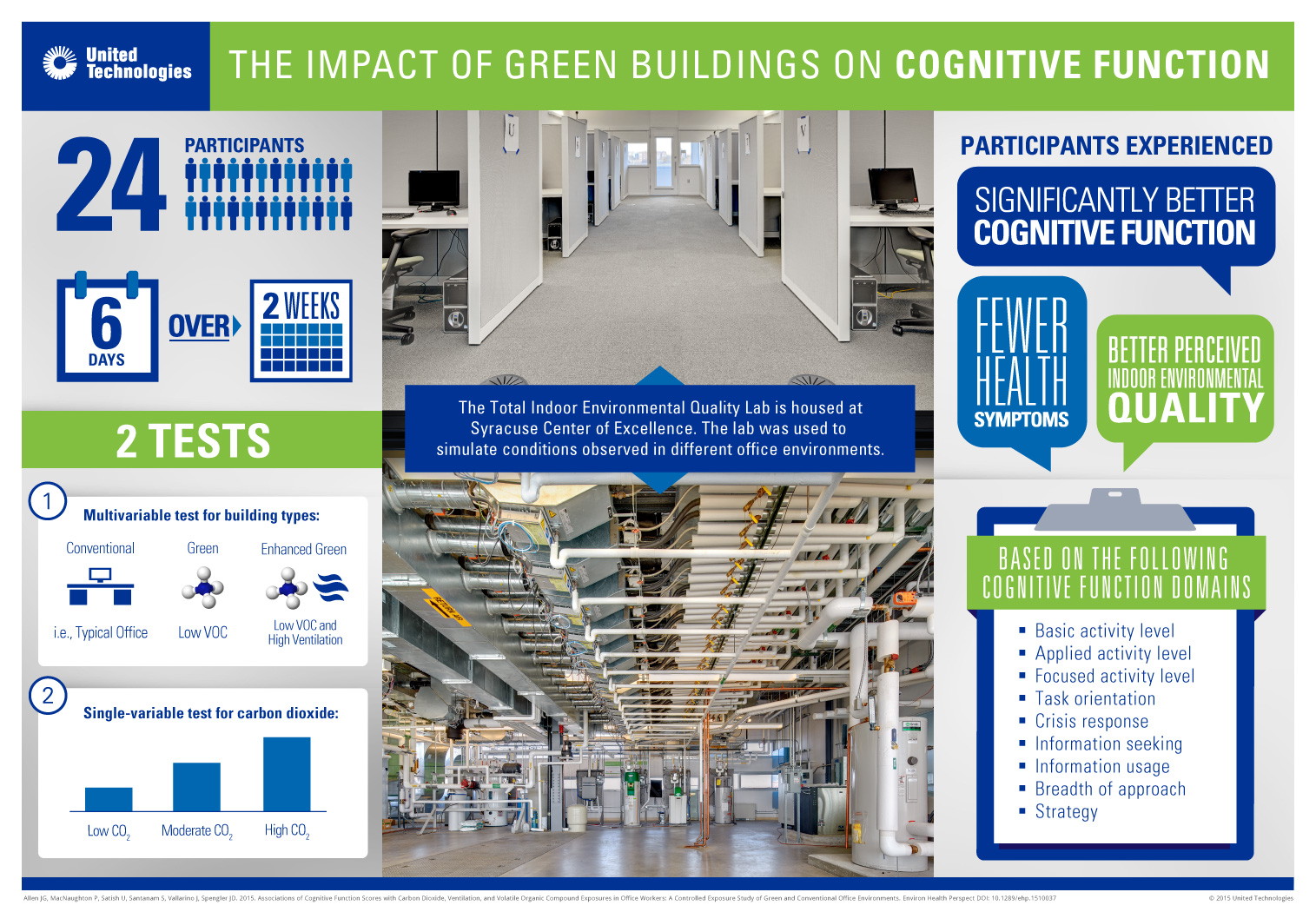We spend a lot of time indoors. According to one study, employed Americans spend a mere 2 percent of their time outdoors. Some of our time is spent in transit (6 percent), but the vast majority of our time, 92 percent, is spent inside.
And according to a new study, all that time indoors is making us stupid.
Published in the journal Environmental Health Perspectives, the study has found that normal indoor levels of carbon dioxide and volatile organic compounds negatively impact human cognitive function and decision-making. These chemicals are found everywhere, from plastics and newspapers to ceiling tiles and vinyl floors. Poor ventilation in conventional buildings was also implicated by the study.
Conducted by a group of scientists from the Harvard School of Public Health, SUNY-Upstate Medical School and Syracuse University, the study adds to a growing body of evidence that indoor air pollution is a serious public health issue. While the vast majority of health-related research has focused on single chemicals, much less is known about the health impact from exposure to a combination of chemicals, as this study investigated.
The researchers observed 24 participants who spent six eight-hour work days in an environmentally controlled office space. On different days, the subjects were exposed to conditions representative of "Conventional" office buildings (which have high concentrations of volatile organic compounds, or VOCs) and "Green" office buildings (which have low VOC concentration). A third condition, labeled "Green+" simulated a green building with a high rate of outdoor ventilation. At the end of each workday, participants completed a 1.5 hour computer-based cognitive assessment test that measured nine functional areas, including basic, applied and focused activity levels; task orientation; crisis response; information seeking; information usage; breadth of approach; and strategy.
The results were striking. On average, the participants' cognitive scores were 61 percent higher on the Green building day and 101 percent higher on the two Green+ building days than on the Conventional building day. The researchers write,
"These findings have wide ranging implications because this study was designed to reflect conditions that are commonly encountered every day in many indoor environments.""Participants spent each day during the test period conducting their normal work activities in indoor environments that are encountered every day by large numbers of workers," said study co-investigator Suresh Santanam. "Because of the controlled way in which the study was designed and conducted within the state-of-the-art lab, we're confident of the results, which are very significant."
The largest improvements in cognitive function test scores occurred in the areas of crisis response, information usage and strategy.
- Crisis response scores were 97 percent higher for the green environment and 131 percent higher for the green environment with enhanced ventilation and lower carbon dioxide levels compared to the conventional environment.
- Information usage scores for green and enhanced green environments were 172 and 299 percent higher than in the conventional environment, respectively.
- For strategy, green and enhanced green scores were 183 and 288 percent higher than the conventional environment.
"First, they suggest that the levels of carbon dioxide and volatile organic compounds that we commonly encounter in conventional office buildings are associated with decreases in worker performance compared to when those same workers are in green building environments. Second, when we enhance ventilation and optimize indoor environmental conditions, we see improvements in the cognitive function of workers. And third, these results fill important knowledge gaps in existing research about the relationship between green buildings and occupant health."
VOCs are organic chemicals that, due to a low boiling point, evaporate from the liquid or solid form and enter the surrounding air at normal room temperatures. Some common VOCs include gasoline, benzene, acetone, formaldehyde and chlorofluorocarbons (CFCs). VOCs are a ubiquitous element of modern life, found in paints, plastics, resins, varnishes, adhesives, solvents, air fresheners, cosmetics, cleaning and disinfecting chemicals, moth balls, newspapers, stored fuels, wall boards, ceiling tiles, carpets, vinyl floors, composite wood products. They are produced by smoking tobacco, wood burning stoves, photocopiers and non-electric space heaters.
According to the Environmental Protection Agency, indoor air pollution can be up to 100 times worse than outdoor air pollution. The impact of this pollution is exacerbated by the fact that we spend so much time indoors. Children are especially vulnerable.
"We know green buildings conserve natural resources, minimize environmental impacts and improve the indoor environment," said John Mandyck, chief sustainability officer of United Technologies Corporation, a building and aerospace technology company based in Farmington, Connecticut, which provided primary support for the study, but was not involved in the collection, analysis, interpretation or presentation of the data. But, he added, "these results show they can also become important human resource tools for all indoor environments where cognitive abilities are critical to productivity, learning and safety."
"The payback for improved indoor environmental quality far outweighs the investment, considering that more than 90 percent of the costs associated with a building are related to the people who work within it once construction is completed," Mandyck added.
The researchers point out that the interest in energy efficiency resulted in less ventilated buildings, which trap more CO2 and VOCs.
The increasing cost of energy in the 1970s led to a change in building practices throughout the United States, as buildings were increasingly constructed to be airtight and energy efficient. This is reflected in decreasing air exchange rates in homes and buildings. For homes, beginning around this time period, typical air exchange rates began decreasing from approximately 1 air change per hour (ACH) to approximately 0.5 ACH ... Homes built in the past decade are designed to be even more energy-efficient and therefore can be even tighter (0.1 - 0.2 ACH) ... Similar to the story with homes, commercial ventilation requirements were lowered in the early 1980s, largely as an energy-conservation measure.The researchers also noted that it was during the ventilation-impaired 1980s when people began to report building-related illnesses and sick building syndrome (SBS), a condition affecting office workers marked by headaches and respiratory problems. A 1984 World Health Organization report suggested that up to 30 percent of new and remodeled buildings worldwide may suffer from poor indoor air quality.
"This study suggests that indoor environments can have a profound impact on the decision-making performance of workers, which is a primary indicator of worker productivity," said Dr. Allen.
Mandyck said, "When it comes to the decision-making ability of green building occupants, intelligence is in the air." Conversely, for people who spend most of their indoor time in conventional buildings, impaired brain function appears to be norm.





Reader Comments
to our Newsletter